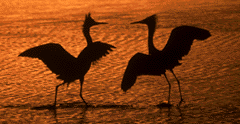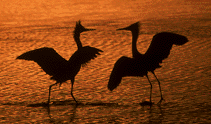SIX WIMBERLEY HEADS ($571.50 INCLUDES SHIPPING)
AND 100 DOUBLE BUBBLES NOW IN STOCK.
PRIBS TRIP REPORT
From July 24 through August 7 I was on St. Paul Island in Alaska's
Pribilofs. I was joined the first week by 10 additional folks, and 9
for
the second week. The photographic opportunities far exceeded everyone's
wildest dreams. On my two previous visits in late June/early July,
finding
a few puffins was somewhat of a chore. At these later dates, both
Horned
and Tufted Puffins were much more numerous. Of the 113 rolls that I
exposed
in the two weeks, surely 2/3 were of puffins. On the last morning,
those
who did not opt to stay in and pack were rewarded with a point-blank
Tufted
Puffin with a mouthful of small fish with large eyes. The bird posed
and
posed and posed at Reef Wall.
During the first IPT, several of us got to photograph a Northern Fur
Seal giving birth at fairly close range. On the last morning with the
first
group, those who went out experienced a clear sunrise--my first ever in
eight weeks on St. Paul. I tired to think of a single spot on the
island
where the early morning sun would be on some cliff-nesting birds in a
situation where the photographers could point their shadows at the
birds.
I
finally came up with a section of cliff west of Ridge (Tourist) Point.
When
we first arrived our targeted nests were in shadow, but within 10
minutes
we
got to photograph a nest-ful of small, down-covered baby Red-Faced
Cormorants. In the 90 minutes that we were able to spend at this spot,
the
birds were fed several times.
On the second IPT, we had great chances with Rock Sandpipers (both
adults
and juveniles). Several participants got to photograph Gray-tailed
Tattler--a Siberian vagrant. Lastly, on consecutive afternoons, strong
south/southwest winds at Southwest Cliffs found numerous Northern
Fulmars
holding in the up-currents just 25 feet from 6-8 eager photographers and
posing for top shots. It was by far the best sustained flight shooting
that
I have ever encountered. (Sorry L.F, Darrell, et. al.)
When a slight wind shift altered the bird's flight patterns a bit, I
switched to vertical format with the Canon 100-400 mm IS lens (that I
used
exclusively with the EOS 1v this trip for flight shooting ). The first
bird
that came by, an intermediate phase, angled himself perfectly to me and
posed for 6 or 7 top-shots at about a 150mm focal length! I could have
grabbed it!
Many rare wildflowers in bloom (in perfect condition) were
photographed
by both groups at Whitney Lake and other locations. I was a bit worried
about taking so many photographers on a St. Paul Island Tour bus, but
the
plan worked out superbly. After the first day or two, we began dropping
folks off at their preferred sites as per their requests. In addition,
many
of the locations
were suitable for 5-10 (or more) photographers.
I may return even later in the season next year. I've heard that
there
are even MORE puffins then.
Using a Wimberley Head with Short Lenses
It was a still Thanksgiving morning. The entire eastern sky at Bosque
Del
Apache NWR in south-central New Mexico flamed red-orange from north to
south. Thousands of Snow Geese swirled about through the intensifying
color. As it seemed that fully half the sky was lit up, the situation
screamed for a wide shot. While reaching for my short zoom lens,
however,
I
realized that my ballhead was still in a suitcase back at the motel
room.
(I
had arrived the night before.) . A Wimberley head was mounted atop my
Gitzo
tripod. This gimbal-type head is ideal for flight shooting; big
telephoto
lenses are rendered practically weightless and handling them is a
breeze.
I
made many wonderful photographs that morning, but the wide image that I
had
visualized was not to be, for mounting a camera body with a short lens
on
a
Wimberley head was not possible. Or so I had thought.
To mount a short lens on a Wimberly head follow these steps:
1-Affix a Really Right Stuff camera body plate to the bottom of your
camera
body or power winder. (Each RRS stuff plate is designed for a specific
camera body or power winder).
2- Place a Hama Double bubble in the camera's hot-shoe.
3-Mount a short lens onto your camera.
4-Remove the clamp platform from the swing shaft by loosening the knob.
5-Loosen the swing knob, point the swing shaft towards the sky (instead
of
at the ground), and then tighten the swing knob.
6-Place the clamp platform onto the swing shaft by sliding it on from
below.
7-Slide the clamp platform up as far as it will go and then tighten it.
8-Mount the camera body onto the clamp platform with the lens pointing
away
from the swing shaft.
9-Point one leg of the tripod at the center of the scene that you wish
to
photograph.
10-Adjust the vertical framing by adjusting the length of the forward
pointing leg by loosening the leg lock, lengthening or shortening the
leg
as needed, and then tightening the leg lock when the desired framing is
achieved. An option is to pull the leg-stop tab on the forward pointing
leg
out and adjust the vertical framing by changing the leg angle.
11- Loosen the swing knob and check the double bubble level in the
camera's
hot shoe to square the camera to the world before re-tightening the
swing
knob. (To make a vertical scenic image, rotate the camera to vertical so
that the swing shaft is parallel to the ground and then check the double
bubble as above.)
12-Make the image.
This technique is perfect for folks who photograph birds or
other
wildlife almost exclusively and who only occasionally attempt to make
scenic images. Some folks have complained that step 10 is "too
difficult"
for them. To them I say, "Get a life!" Adjusting the vertical framing
is
simple and the directions are straight-forward. Thanks to good friend
and
IPT participant Darrell Miller for improving on my original method by
suggesting step 5 which allows you to shoot any wide angle off of the
Wimberley head.
The upper photograph below (or attachment Wimberley 5) shows the set-up
for
making horizontally formatted images. The lower photograph below (or
attachment Wimberley 4) shows the correct set-up for making vertically
formatted images.
BIRDS AS ART INSTRUCTIONAL PHOTO-TOUR UPDATES.
Still only two folks have signed up for the Jamaica Bay Wildlife Refuge
Shorebird IPT (AUG 28-30). Ideal early morning high tides should make
for
some great photography for those who would like to crawl through the
muck.
>
The OCT 1-3 Cape May Raptor IPT has one spot left (limit three). The
other two are sold out.
The SEPT 9 JBWR FIELD SHOOT is sold out. There is room on the AUG 26
FIELD
SHOOT. And lots of room for the two "The Art of Nature Photography"
Full
Day How-To Seminars in the NYC area;
AUG 27--Oyster Bay, Long Island, NY, and SEPT 10--Bayside, Queens, NY
See the web site for details and additional INFO.
Best and great picture making to all.
Arthur Morris/BIRDS AS ART


